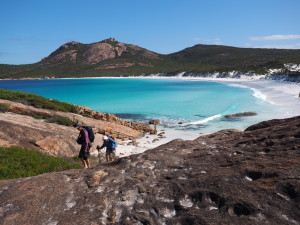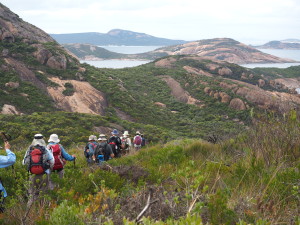Cape Le Grand Coastal Trail – review
Cape Le Grand Coastal Trail – review
Posted on

If you’re heading to Cape Le Grand National Park, make time to do at least some of the Cape le Grand Coastal Trail while you’re there. Over two days we did three of the four sections on our South Coast Explorer tour this year, plus Frenchman’s Peak.
The Cape le Grand Coastal Trail is broken up into four sections, each of which is accessible at each end by vehicle. If you’ve got someone in your group who doesn’t like walking, or you’re on one of our tours, you can get dropped off and picked up at each end. Otherwise a return walk from your car isn’t the worst thing in the world – it’s pretty amazing scenery both ways.
By myself, I took all day to do the whole trail, which is apparently about 15 km all up (it felt a bit longer). In a group we tend to move at a slower pace and enjoy more swims and lookouts so we split the walk over two days. Here’s a quick rundown on each of the sections, from west to east.

Cape Le Grand to Hellfire Bay (Hard, allow 3 hours)
The westernmost section, from Cape Le Grand Beach to Hellfire Bay, is probably my least favourite. There are a lot of awkward sideways angles that my hips and feet don’t like much. Plus the trail is mainly aligned quite a way from the coast so the views aren’t as speccy as in the other sections. There are lots of great granite formations and lizards to keep you interested though and maybe I was just in a bad mood when I did it. Not one for wet weather because of the slippery granite hills.
Hellfire Bay to Thistle Cove (Hard, allow 2 – 3 hours)
This is my favourite section! There are some very steep hills (up and down) but the views out to the Researche Archipelago and into the bays are incredible. I wouldn’t do this section if it was really wet because the very steep granite slopes can get quite slippery. There’s one section in the middle where you have to do some balancing and rock hopping to get around a delightful little cove. This can be a challenge for some, especially if the tide is high, so take a friend and help each other out.
I’m not sure if would be any easier or harder walking Thistle Bay to Hellfire Bay. There are toilets and a good undercover picnic area at Hellfire Bay though, which might influence which way you walk.
Thistle Cove to Lucky Bay (Easy, allow 1 hour)
My second favourite section is Thistle Cove to Lucky Bay (either direction). It’s an easy section for the most part and the views are really good. You can walk straight from the Lucky Bay campground if you like. And the path, at the Lucky Bay end, is very well formed; so it’s definitely a good section to try first if you’re not sure about your abilities or the walk itself. Just go as far as you’re comfortable and turn back when you feel like it.
Lucky Bay to Rossiter Bay (Medium, allow 2 hours)
I switched directions when I walked the eastern-most section so I walked from Rossiter Bay to Lucky Bay. I reckon this section is best in the morning with the sun behind you as you’re coming into Lucky Bay. I’ve done it in the morning and the late afternoon though and both were nice. There are a couple of hills, but none are too steep and it’s a mixture of firm sand, granite and gravel underfoot.
I do think they should realign part of this section to take it closer to the coast. As it is now, you miss out on some wonderful ocean views if you stay on the track. Coming down to Lucky Bay is very nice though and the 2.5 km beach walk into Lucky Bay campground is mostly very firm and quite lovely. For those who hate soft sand beach walking, this one won’t faze you at all.
The Cape Le Grand Coastal Trail in a nutshell
This Cape le Grand Coastal Trail certainly has it’s difficulties – mostly in the form of steep ups and downs on granite outcrops, which are sometimes at awkward angles. You wouldn’t want to do the sections between Cape Le Grand Beach and Thistle Cove in the wet. In fine weather though, the views are sensational – especially in the sections between Hellfire Bay and Lucky Bay.
All in all the coastal trail is an excellent walk which I would highly recommend if visiting Cape Le Grand National Park. Bring your walking poles to help your knees on the downhill slopes and take your time. Perhaps break it up over 2 days.
You can see photos of our tour of Cape le Grand & Fitzgerald River NP tour on our flickr page or check out our tour page here.




